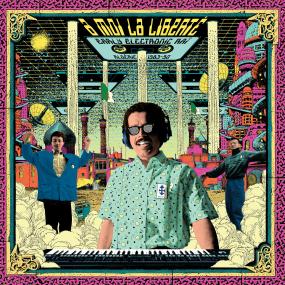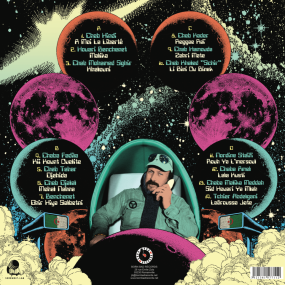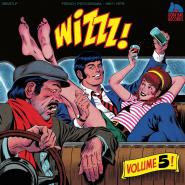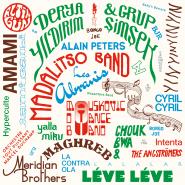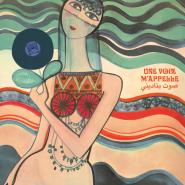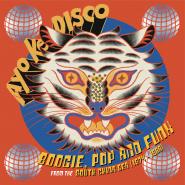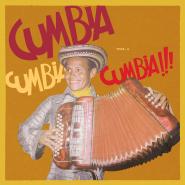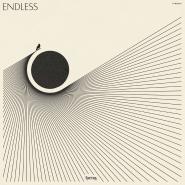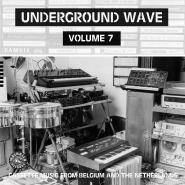A MOI LA LIBERTE "EARLY ELECTRONIC RAI - ALGÉRIE - 1983/1990" by VARIOUS ARTISTS
| SKU | 129341 |
| Artist | VARIOUS ARTISTS |
| Title | A MOI LA LIBERTE "EARLY ELECTRONIC RAI - ALGÉRIE - 1983/1990" |
| Label | BORN BAD RECORDS |
| Catalog # | BB 160LP |
| Tag | |
| Release | W 26 - 2023 |
| Format | Vinyl - EU2LP |
| EAN Barcode | 3521381577112 |
| Benelux exclusive, Import | |
| € 34,99 | incl. VAT, excl. shipping |
Tracks
- Cheb Hindi - A Moi La Liberte
- Houari Benchenet - Malika
- Chab Mohamed Sghir - Khalouni
- Chaba Fadila - Kii Kount Ouelite
- Cheb Tahar - Djehida
- Cheb Djalal - Mohal Nahna
- Benchenet - Ghir Hiya Salbetni
- Cheb Kader - Reggae Rai
- Chab Hamouda - Zahri Mate
- Cheb Khaled 'Schir' - Li Bini Ou Binek
- Nordine Staifi - Rouh Ya L'mersoul
- Chaba Amel - Lala Kusti
- Chaba Malika Meddah - Sid Houari Ya Mlah
- Tchier Abdelgani - Laaroussa Jate
Description
Delving into the deepest recesses of raï, this compilation serves as a tribute to its roaring years, but also as a rejuvenation of the genre in its sulphurous, subterranean version.
It seemed like a good idea to dig into nearly untraceable cassettes, thus confirming it’s in the oldest of Oranese pots that the very best of raï is to be found. Just 50 years ago, no one would have believed even a bit in a genre seemingly bound to forever turn round and round in its native Oran, laying low in one of its many coastal road clubs. In these underground venues, singers – backed up by a minimalist orchestration for lack of space – would move their audience to laughs and tears, sobbing in a beer or chuckling down (dry) whisky. Either way, the public would unfailingly be moved by their defying tunes, sounding like a challenge to the established, self-righteous order of things – complete with trumpets, electric guitars, accordions and an array of percussions. Through the pre and post-independence years, from 1950 to 1970, raï urbanised itself, with a generation growing up between asphalt and concrete to the sound of traditional flute, but also and mostly listening to twist, French variété and rock music. Their names were Boutaïba S’ghir, Messaoud Bellemou, Groupe El Azhar, Younès Benfissa or Zergui, and they passed on their collection of songs to the incoming “Chebs” –breathing a second youth into them. Oran, the capital of West-Algeria, will be at the heart of this rejuvenation.
Overshadowed to the West by the bare mountain of Aïdour, a foot set onto a beautiful bay and the other on a long dried out wadi, covered up with buildings since, Oran must be the most European of Algerian towns – regardless of its kasbah, its sanctuary built in 1793 under the reign of the Bey Mohammed ben Othman and devoted to Sidi El Houari, the city’s patron saint, and praised in many a raï song, and its Pacha 18th century mosque built in memory of the displaced Spaniards of 1492. The bare minimum, you could say, for a town formerly known as Ifri – or the cave, in Berber – and conceived in 903 under the name of Wahrane – the lions, again in Berber – by Andalusian seamen. The most notable, though, is its Christian legacy, mostly passed on by the Spanish who occupied the city for the best of two hundred years, from the beginning of the 12th century. To name a few, there’s Saint-Louis’ church, the Sacred Heart cathedral or the Virgin’s chapel. Oran is blessed with the sea, with its hue more intensely blue than elsewhere, and pine forests all around and above it, towards Sana Cruz. In short, it is rich with Hispanic, Andalusian, Turkish, Arab-Berber and French influences.
This cosmopolitanism is very much part of the city’s largely jovial nature. Staying up late is an enduring habit in Oran. Seaside walks on the ALN (former sea front) are never ending and the eyes riveted on the port, never tiring. Later still, some head for the open air theatre, renamed Cheb Hasni in honour of the creator of love raï, killed on September the 29th, 1994. Others take over restaurants – especially the ones with fish on the menu – before taking it all out on the dance floor of one of the many clubs dotted along the coastal road. The most famous ones are called “Le Florida” and “Le Dauphin”, and their number has been on the rise in the past years – even though Oran was, at one point, also hit by acts of violence. The clubs that have witnessed the beginnings of Khaled, Cheb Mami, Fadéla and Sahraoui, Houari Benchenet or Cheb Hindi remain the natural habitat of raï and a breeding ground for new talents.
Oran did however suffer from its frivolous reputation and the openly disdainful attitude of the rest of Algeria towards it. Its inhabitant easily reassure themselves though, mocking all of these Algerians and Constantinians who take over their city’s beaches to hit on “petitates”, these girls known to be promiscuous (sometimes even students) and often looking for a “beggar” (literally, a cowboy; a nouveau riche who likes showing off his smartphone and big wad of cash at the club). Some also come to Oran to chat up the “mariquitas” (queens wearing an outrageous amount of make-up) haunting the water front.
The birthplace of raï, where Johny Hallyday (and before him, Louis Armstrong and Josephine Baker) performed at the Casino in 1966, has always been known as the country’s affordable slumming spot. The pleasure of the flesh and inebriation recounted in many a raï song is no legend, and in Oran, illegitimate love affairs are still a great source of delight.
Before becoming an international musical phenomenon, raï was first and foremost the expression of a social behaviour, of a way of being. It bothers, excites, seduces, but leaves no one indifferent! Especially particular intellectual, political and religious groups who have always declared their hostility towards what they consider to be no more than a vulgar and trivial cultural by-product. Presumably born in 1920 somewhere on the Oranese plains, the movement gains breadth in the 40s and 50s, years of majors challenges, which have seen the emergence of the “cheikhate” (feminine plural of “cheikha”, the equivalent of the masculine “cheikh), of which the late Rimitti was the emblem, propelling their innuendo-heavy melodies in the brothels, second-class dancehalls and private parties that could turn into near-Saturnalias. The genre was then modernised in the 60s and 70s, by artists such as Blaoui Houari, Ahmed Wahby, Messaoud Bellemou, Bouteldja or Ahmed Saber. However, the musical arrangements and architecture still lacked depth and consistency. A major artist of the Oranese scene, Rachid Baba Ahmed – born on the 20th of August 1946 in Tlemcen, a middle-class city custodian of the “gharnati”, a traditional art from Andalusia, with its well-structured and conscientious melodies – will finally give the genre the adornment it deserved. His father, well-off both in monetary terms but also artistically, played the “rebab” – traditional violin – with the city’s most renown orchestra, conducted by Larbi Bensari.
Rachid will keep a fond memory of his father’s music – though, as a teenager, he preferred rock and twist. In the early 60s, at a time when, all across Algeria, bands with (often) Americanised names would set the dance floors of the emerging tourist developments alight, he buys himself a guitar, and with his brother Fethi, covers standards with lyrics sung in Arabic. Success will come in 1972, with a video clip produced by Oran’s television station, in which the pair is seen riding big motorbikes. The brothers rightfully sensing raï’s wind rising – a genre they didn’t readily identify to – decide to open up a sophisticated studio, the Rallye, in reference to Rachid’s love for car racing. There, they take charge of the destiny of various singers, of which Fadéla, Khaled, Benchenet, Sahraoui or Djalal. Suspicious at first, local producers and editors entrust their protégés to the brothers, accumulating meetings at the studio. Rachid, apart from having a very convincing personal touch, gives a central focus to synth parts, enhanced by acoustic and electric guitars and drum machine. He introduces eccentric electronic parts, under the asserted influence of Jean-Michel Jarre. A virtuoso on the decks, he finally gains a reputation as a controller and studio concept genius. Hits, clips and famous variety television programs – such as “Top Rai” or “Wach Raïkoum” (What do you think?) – accumulate. Also known for dressing in military outfits, wearing varied hats and speeding with his 4x4, Rachid is shot dead in Oran on February the 15th. Luckily, he’ll have had time to witness his pupils’ triumph when raï truly explodes in the 80s, and, like a tidal wave, sweeps onto the public mind. His armada of singers, called “cheb” (young), is to radically transform the musical scene and shake up the foundations of the old cultural aristocracy, of which the most fearsome “tasks” had been to demean popular forms of expression and attempt to ban its manifestations.
“To live and let live” – his keen, impatient creed disseminated by hundreds of thousands of cassettes, did much more than seducing: it conquered a whole youth, predominant in number though excluded socially, baffled by idleness, stadium chauvinism and the media’s patriotic lingo, trapped between the bar, the mosque and a virtually inexistent leisure market.
Raï’s success was overwhelming, so much so that in 1985 – when it appeared at the Youth Festival in Alger and when Oran held its first raï festival – the Algerian authorities hastened to nationalise the genre, all the while calling for its “normalisation” (that is, the “purification” of its lyrics), and to declare it “an integral part of the national heritage”. About a year later, raï is introduced to France via two festivals, one in Bobigny and the other at La Villette. They brought together all of the big names of raï, old and new, and drew in a public mostly made out of nostalgic blédards (a French expression designating a person originating from the Maghreb), plus a handful of curious onlookers. In France, raï doesn’t stir much enthusiasm – if not in the media, or of a sociological kind. While in the Maghreb cassettes dealers are regularly ransacked, only a few French labels dare investing themselves in the recognition of a music bringing a new fresh wind, seducing and conquering other Algerian as well as Moroccan cities and regions. Later on, the Oranese style gains international appreciation and evolves technically – though more technique also means less feeling. Luckily though, the historical channel raï to be heard in the dives and discos survives its shinier cousin - sex, alcool and raï’n roll style.
In the late 70s, Chaba Fadéla, born in 1962 and noticed early on for her role in the TV film “Le gaucher” (the leftie), gives electric raï its first voice. She’s only 17 years old at the time, but ignores the ban prohibiting her from performing in cabarets. An ex-Boutaïba Sghir backup singer, she is supported by the famous trumpet player Messaoud Bellemou. In the 90s, she will even perform abroad, forming a duo with her then husband. She is part of the generation made up of Khaled, Mami, Cheb Hindi and Benchenet.
The latter was born in Oran, on the 25th of May 1960, to a large and modest family. Influenced by Blaoui Houari, Ahmed Wahby, Ahmed Saber and Ben Zerga, the leading figures of Oranese chanson and heralds of modern raï, Benchenet takes his first musical steps in 1975. A former student at the Ibn Khaldoun secondary school, a specialist in the civil part of metal construction, he first tested his skills as a singer and musician performing for his neighbourhood friends in the Plateau before making the great leap and performing for weddings and circumcision ceremonies. His charisma on stage and subtle way of playing the organ are well appreciated, landing him a fair number of gigs.
In 1977, he is spotted by Belkacem Bouteldja, known as “Kacimo”, an absolute raï-pop star at the time, who lets him sing in his place once in a while. Benchenet’s voice, soft and clear, is a pleasant surprise for the audience and has him noticed by Abdelkader Cassidy, a production pioneer who will get him to record his first cassette – a success. Houari, who never bothered with the particle “cheb”, is propelled to the scene’s forefront and starts writing his own songs – for the most part robbed by his direct competitors.
What sets him apart from his “coreligionists” is his romantic touch, his way of setting the scene and redefining tenderness. A fine melodist and the author of many outstanding ballads, he is the founder of “rai love” – turned into a genre of its own by the late Cheb Hasni.
His pal, nicknamed El Hindi due to his immoderate love for Bollywood movies, first sung with the boy scouts, then recorded a dozen of confidentially successful cassettes before triumphing with “A moi la liberté”. They will sometimes team up with the late Cheb Tahar, who was both a great singer and dancer – giving his representations a dramatic effect.
Like in the case of Mogamed Sghir, a kid coached by his famous father for his voice, Mogamed Belardi, a virtuoso drummer and percussionist, was also the author of poetic writings, which his son’s falsetto would bring out the best of.
Cheb Hamouda, a reggae fan, has five recordings to his credit, the last of which goes back to 1991 – he never planned for a career, just like Tchier Abdelghani and his extremely rare production. Their feminine counterparts – like Chaba Amel with her timbre as heady as the scent of jasmine, or the captivating Malika Meddah, combedian and ex-scholar – found more luck on their path. And what about the non-Oranese: Cheb Djala, born in Sebdou in the region of Tlemcen, with his style bringing together popular Moroccan music (introducing the lute) and raï, Rachid and Fethi style - his initial producers, hailing from the same region; Rostane Benali, arranger for Cheb Hasni and Khaled, or here for the latter’s fan: Khaled Sghir, with his great appearance in the king of raï’s clip “Chaba”, born in 1965 in Alger; and above all, the magnificent Nordine Staïfi (1956-1989), who lived in Chambéry until his death, promoter of “staïfi” – a sort of compromise between melodies from Eastern Algeria’s Highlands, swaying rhythms from Aurès and Oranese groove. Meanwhile, the Moroccan-French Cheb Khader tasted international success in the 90s after a first opus, “Awama” (the Sorceress), from which “Reggae-Raï” is taken.
And today, this compilation is a tribute to the kind of raï which, still and always, makes us love raï.

